International Workshops & Master Classes
Avikk’s unique combination of acfhievements, integrity, international success and multi-disciplinary expertise makes him one of the most respected judges in the industry. This unique versatility is why he’s consistently invited to judge prestigious events, from highly specialized art forms to all kinds of professional Competitions, accross Diverse Professions.
Corporates & Educational Organisations
Avikk’s experience as a communication coach, performer, director, and producer allows him to deliver a wide array of workshops and masterclasses tailored to the needs of corporate and educational organizations. His training covers critical areas such as communication skills, team dynamics, creative thinking, and leadership. These sessions are designed to be interactive and impactful, equipping participants with skills that are valuable in any professional or academic setting. Here is an in-depth look at the range of workshops and masterclasses Avikk offers for corporate teams, educational institutions, and similar fields.
Click to EXPAND on each below:
1. Communication Skills
1.1. Verbal Communication Mastery
- Techniques for clear, confident, and effective verbal communication.
- Crafting impactful messaging for presentations and meetings.
- Managing tone, pace, and articulation to engage audiences.
1.2. Non-Verbal Communication
- Understanding and harnessing body language, gestures, and facial expressions.
- Techniques to convey confidence, empathy, and openness.
- Developing awareness of non-verbal cues for stronger connections.
1.3. Cross-Cultural Communication
- Adapting communication styles for diverse cultural settings.
- Navigating language barriers and understanding cultural nuances.
- Techniques for inclusive, respectful cross-cultural interactions.
1.4. Active Listening Skills
- Strategies to improve listening and comprehension.
- Exercises to enhance empathy and understanding in communication.
- Building trust and rapport through attentive listening.
2. Leadership and Team Building
2.1. Transformational Leadership
- Strategies for inspiring and empowering teams.
- Understanding individual and team motivations.
- Exercises to build a compelling vision and lead with authenticity.
2.2. Collaborative Team Dynamics
- Techniques for fostering teamwork and synergy.
- Exercises to build trust, respect, and open communication.
- Resolving conflicts and managing group dynamics effectively.
2.3. Emotional Intelligence for Leaders
- Building self-awareness, empathy, and resilience in leadership.
- Techniques for managing emotions and making thoughtful decisions.
- Using emotional intelligence to improve team morale and productivity.
2.4. Leading with Influence and Persuasion
- Techniques for influencing without authority.
- Understanding motivational psychology and persuasion.
- Building credibility and inspiring action within teams.
3. Presentation Skills and Public Speaking
3.1. Presentation Techniques for Impactful Delivery
- Structuring presentations for clarity and engagement.
- Techniques to project confidence and connect with audiences.
- Using storytelling to make presentations memorable.
3.2. Mastering Stage Presence
- Techniques to manage nerves and perform with charisma.
- Using movement, gestures, and eye contact effectively.
- Exercises for adapting stage presence to various audience sizes.
3.3. Engaging Virtual and Hybrid Audiences
- Techniques for delivering effective virtual presentations.
- Using technology and virtual tools to enhance audience engagement.
- Adapting body language and tone for online communication.
3.4. Voice and Articulation Training
- Exercises for clear, strong voice projection.
- Techniques to vary tone and pace for audience engagement.
- Managing vocal energy and stamina in long presentations.
4. Conflict Resolution and Negotiation
4.1. Conflict Management Skills
- Techniques to identify, address, and resolve conflicts constructively.
- Understanding the roots of conflict and promoting open dialogue.
- Exercises for remaining calm and composed under pressure.
4.2. Persuasive Negotiation Skills
- Building negotiation strategies that focus on win-win outcomes.
- Techniques to enhance negotiation confidence and assertiveness.
- Adapting negotiation approaches for different stakeholders.
4.3. Building Empathy in Workplace Interactions
- Exercises to increase empathy and understanding in communication.
- Techniques for de-escalating conflicts with empathy.
- Using empathy to improve team dynamics and morale.
5. Creativity and Innovation in the Workplace
5.1. Enhancing Creative Thinking
- Techniques to cultivate a creative mindset and break mental barriers.
- Brainstorming and ideation exercises for innovative solutions.
- Building a work culture that encourages risk-taking and creativity.
5.2. Problem-Solving through Improvisation
- Using improvisational techniques to think on the spot.
- Exercises for flexible thinking and adaptability.
- Solving workplace challenges creatively through improvisation.
5.3. Storytelling for Business Innovation
- Techniques for crafting compelling business narratives.
- Using storytelling to inspire creativity and innovation.
- Building narratives that engage and motivate stakeholders.
6. Emotional and Mental Well-being
6.1. Stress Management Techniques
- Practical exercises to identify and manage workplace stress.
- Breathing, mindfulness, and relaxation techniques.
- Creating work-life balance and reducing burnout.
6.2. Building Resilience in Challenging Times
- Techniques for developing mental toughness and adaptability.
- Understanding and embracing change as a growth opportunity.
- Exercises to reframe setbacks and maintain optimism.
6.3. Mindfulness and Focus in the Workplace
- Strategies to improve focus, concentration, and mental clarity.
- Techniques for practicing mindfulness at work.
- Exercises for maintaining calm and productivity under pressure.
7. Interpersonal Skills and Relationship Building
7.1. Building Rapport and Trust in Teams
- Techniques to create strong, positive relationships at work.
- Understanding personality types and adapting communication styles.
- Exercises for building trust, respect, and rapport in teams.
7.2. Networking and Professional Relationship Building
- Techniques for effective networking and relationship building.
- Building a professional network through meaningful connections.
- Maintaining long-term professional relationships.
7.3. Communicating with Confidence and Assertiveness
- Techniques for assertive communication without aggression.
- Setting boundaries and speaking up confidently.
- Building self-assurance in professional settings.
8. Sales, Marketing, and Brand Communication
8.1. Storytelling for Sales Success
- Crafting compelling stories that resonate with customers.
- Using narrative techniques to create memorable sales pitches.
- Building customer loyalty through authentic storytelling.
8.2. Brand Communication and Consistency
- Techniques for maintaining brand voice and consistency.
- Creating emotional connections with audiences through communication.
- Adapting brand messaging for different platforms and demographics.
8.3. Persuasive Techniques in Sales
- Using psychology-based techniques to persuade customers.
- Understanding customer needs and adapting sales approach.
- Exercises to build persuasive, engaging sales pitches.
9. Diversity and Inclusion
9.1. Building Inclusive Work Environments
- Techniques to create a culture of inclusivity and respect.
- Understanding unconscious bias and promoting diversity.
- Exercises for creating an open, inclusive workplace.
9.2. Cross-Cultural Awareness and Sensitivity
- Developing cultural sensitivity and understanding.
- Adapting communication for diverse teams and clients.
- Building an inclusive, collaborative work environment.
9.3. Effective Communication Across Generations
- Techniques to bridge communication gaps across age groups.
- Understanding generational perspectives and preferences.
- Building inclusive communication that resonates with all ages.
10. Event Hosting, Emceeing, and Public Engagement
10.1. Professional Hosting and Audience Engagement
- Techniques for engaging audiences in formal and informal settings.
- Managing event flow, adapting tone, and using humor effectively.
- Creating memorable experiences through engaging hosting.
10.2. Facilitating Panels and Conferences
- Techniques for moderating and managing discussions.
- Building rapport with panelists and engaging audiences.
- Using questioning techniques to elicit insightful discussions.
10.3. Public Engagement and Crowd Interaction
- Techniques for energizing and engaging live audiences.
- Adapting to different audience dynamics and event styles.
- Exercises for building presence and commanding attention.
11. Performance and Presentation Coaching for Executives
11.1. Executive Presence and Charisma
- Techniques to build authority and approachability.
- Exercises to enhance gravitas, charisma, and engagement.
- Understanding the balance of professionalism and authenticity.
11.2. Advanced Presentation Skills for Executives
- Structuring complex presentations for clarity and impact.
- Techniques for audience analysis and message adaptation.
- Handling Q&A sessions confidently and effectively.
11.3. Media Training and Interview Skills
- Techniques for managing interviews and media interactions.
- Staying composed under scrutiny and conveying key messages.
- Adapting responses for different media formats.
Avikk’s extensive expertise across communication, performance, leadership, and team dynamics enables him to deliver a wide range of impactful workshops and masterclasses for corporate and educational organizations. Each workshop addresses unique aspects of professional and personal development, making them versatile for a variety of settings.
Click to EXPAND on each below:
1. Professional Communication and Presentation Skills
1.1. Effective Verbal Communication
- Techniques for clear and persuasive speaking.
- Mastering articulation, voice modulation, and tone.
- Crafting concise, impactful messages for various professional settings.
1.2. Non-Verbal Communication and Body Language
- Using posture, gestures, and expressions to reinforce messages.
- Building confidence and assertiveness through body language.
- Understanding cultural differences in non-verbal cues.
1.3. Public Speaking and Presentation Skills
- Overcoming stage fright and projecting confidence.
- Structuring presentations for maximum impact and engagement.
- Techniques for handling Q&A sessions and adapting to audience feedback.
1.4. Cross-Cultural Communication
- Understanding and adapting to diverse communication styles.
- Building rapport and avoiding misunderstandings in multicultural teams.
- Practical techniques for bridging communication gaps in global settings.
2. Leadership and Team Dynamics
2.1. Building Leadership Presence
- Techniques to inspire and lead teams effectively.
- Building a personal leadership style and honing decision-making skills.
- Balancing empathy and authority to build strong team connections.
2.2. Collaborative Teamwork and Synergy
- Exercises to enhance team collaboration and cohesion.
- Building mutual respect and clear communication within teams.
- Understanding team roles and leveraging diverse strengths.
2.3. Conflict Resolution and Negotiation Skills
- Techniques for constructive conflict resolution.
- Strategies for turning disagreements into productive discussions.
- Building negotiation skills for both internal and external relationships.
2.4. Leading Creative Teams and Innovation
- Fostering creativity and innovation within teams.
- Balancing structure with flexibility to drive results.
- Techniques for nurturing a culture of continuous improvement.
3. Emotional Intelligence and Workplace Dynamics
3.1. Emotional Intelligence in Professional Settings
- Understanding and managing one’s own emotions.
- Techniques for building empathy and understanding in the workplace.
- Practical exercises to develop emotional awareness and responsiveness.
3.2. Building Resilience and Stress Management
- Techniques for handling high-stress environments.
- Developing mental resilience and maintaining a positive mindset.
- Exercises for personal balance and managing work-life integration.
3.3. Mindfulness and Focus Techniques
- Using mindfulness for stress reduction and focus enhancement.
- Practical exercises to maintain calm and clarity under pressure.
- Applying mindfulness for improved productivity and well-being.
3.4. Navigating Workplace Dynamics
- Understanding hierarchy and power structures.
- Techniques for effective upward and peer communication.
- Managing workplace relationships for a healthy work environment.
4. Creativity and Innovation in the Workplace
4.1. Creative Problem-Solving Techniques
- Structured approaches for brainstorming and ideation.
- Techniques to approach problems from multiple perspectives.
- Exercises to foster out-of-the-box thinking.
4.2. Building a Culture of Innovation
- Encouraging a proactive approach to new ideas.
- Techniques for developing an open, idea-friendly environment.
- Strategies to drive continuous improvement and adaptability.
4.3. Design Thinking and Innovation Process
- Introduction to design thinking principles.
- Applying empathy, ideation, and prototyping to problem-solving.
- Practical exercises to implement design thinking in teams.
4.4. Boosting Individual Creativity
- Exercises to unlock personal creative potential.
- Balancing logical and creative thinking for innovation.
- Techniques for maintaining creative energy and motivation.
5. Effective Collaboration and Remote Team Engagement
5.1. Virtual Team Communication
- Techniques for effective communication in virtual settings.
- Managing remote teams and building a sense of connection.
- Adapting communication styles to online platforms.
5.2. Collaboration Tools and Best Practices
- Introduction to effective tools for virtual collaboration.
- Strategies for managing remote tasks and responsibilities.
- Best practices for virtual meetings and project management.
5.3. Building Trust in Virtual Teams
- Techniques to foster trust and connection in remote teams.
- Exercises for team-building in virtual environments.
- Managing challenges unique to remote collaboration.
5.4. Cross-Functional Collaboration
- Techniques for effective collaboration across departments.
- Overcoming barriers in cross-functional teams.
- Balancing competing priorities and finding common goals.
6. Personal Development and Self-Management
6.1. Time Management and Productivity
- Techniques for prioritizing tasks and managing time effectively.
- Setting achievable goals and avoiding burnout.
- Exercises to enhance productivity and reduce procrastination.
6.2. Confidence-Building and Self-Empowerment
- Exercises to build self-confidence and assertiveness.
- Techniques to recognize and overcome self-limiting beliefs.
- Building a positive self-image and projecting strength.
6.3. Career Development and Goal Setting
- Creating actionable career plans and setting milestones.
- Techniques for developing a growth mindset.
- Identifying and pursuing opportunities for skill enhancement.
6.4. Adaptability and Growth Mindset
- Exercises to embrace change and adapt to new environments.
- Techniques to maintain a flexible, positive outlook.
- Building resilience and thriving in evolving industries.
7. Corporate Storytelling and Brand Building
7.1. Storytelling for Impactful Communication
- Techniques for crafting compelling corporate narratives.
- Building emotional resonance through storytelling.
- Using stories to communicate brand values and culture.
7.2. Brand Communication and Messaging
- Developing consistent, powerful brand messaging.
- Techniques for aligning messaging with corporate goals.
- Building an authentic, recognizable brand voice.
7.3. Presentation and Pitching Skills
- Techniques for creating persuasive and memorable presentations.
- Structuring pitches for clarity and impact.
- Exercises for handling objections and questions effectively.
7.4. Building Personal Brand within a Company
- Techniques for establishing a professional reputation.
- Building credibility and positioning oneself as an asset.
- Networking and personal branding within corporate environments.
8. Hosting, Moderation, and Event Facilitation
8.1. Hosting Corporate Events and Panels
- Techniques for engaging and energizing audiences.
- Adapting style and tone to corporate settings.
- Managing event flow and handling unexpected situations.
8.2. Workshop and Seminar Facilitation
- Techniques for keeping participants engaged and focused.
- Structuring workshops for interactive learning and collaboration.
- Exercises for managing group dynamics and encouraging participation.
8.3. Moderating Discussions and Panels
- Techniques for balanced, effective panel moderation.
- Managing diverse opinions and ensuring respectful dialogue.
- Preparing thoughtful questions and managing time constraints.
8.4. Public Speaking for Internal and External Events
- Techniques for inspiring and informing audiences.
- Developing confidence in public speaking for various settings.
- Tailoring messages to different audiences and objectives.
9. Educational Training for Students and Academic Institutions
9.1. Public Speaking for Students
- Techniques to build confidence in young speakers.
- Exercises for clear, persuasive speaking.
- Handling anxiety and building stage presence.
9.2. Effective Study Habits and Time Management
- Strategies for managing academic workloads effectively.
- Techniques to build efficient study routines.
- Exercises for goal setting and prioritization.
9.3. Leadership and Teamwork for Student Leaders
- Skills for leading student organizations and teams.
- Building collaboration skills and managing group projects.
- Techniques for resolving conflicts and enhancing team cohesion.
9.4. Personal Development for Career Readiness
- Building self-confidence and professional etiquette.
- Techniques for effective resume writing and interview preparation.
- Understanding career pathways and personal strengths.
10. Creative Arts and Performance-Based Workshops for Corporate and Academic Settings
10.1. Improv Techniques for Workplace Creativity
- Exercises to enhance spontaneity and quick thinking.
- Building trust and teamwork through improvisation.
- Techniques to foster creativity in high-pressure situations.
10.2. Expressive Arts for Emotional Intelligence
- Using expressive arts for self-discovery and emotional awareness.
- Techniques to build empathy through role-playing.
- Exercises to improve non-verbal communication and self-expression.
10.3. Team-Building through Performing Arts
- Dance and movement-based team-building exercises.
- Enhancing communication and trust through collaborative arts.
- Building team spirit in a fun, engaging setting.
Avikk’s extensive expertise across communication, performance, leadership, and team dynamics enables him to deliver a wide range of impactful workshops and masterclasses for corporate and educational organizations. Each workshop addresses unique aspects of professional and personal development, making them versatile for a variety of settings.
Acting, Dance & Performing Arts
Avikk’s achievements & background in performing arts positions him as a truly Complete Performer, bringing unparalleled versatility and depth to every workshop he leads. His expertise spans a broad spectrum of performing arts, allowing him to offer workshops and masterclasses that cover the intricacies of solo performance, duet dynamics, group choreography, improvisation, acting, singing, amking music, hosting and more. Here is an exhaustive list of workshops and masterclasses Avikk can provide within the realm of performing arts, each underscoring his unique expertise and contributions to the field.
Click to EXPAND on each below:
1. Solo Performance and Stage Mastery
1.1. Confidence and Charisma on Stage
- Techniques for overcoming stage fright and building stage presence.
- Cultivating charisma and captivating audiences.
- Using gestures, posture, and energy to command attention.
1.2. Voice Modulation and Projection
- Voice control techniques for effective delivery.
- Exercises for vocal power, clarity, and expressiveness.
- Mastering voice modulation to add depth and engagement to performances.
1.3. Physical Expression and Movement
- Utilizing body language to convey emotion and narrative.
- Techniques for dynamic movement and fluidity on stage.
- Understanding spatial awareness and stage utilization.
1.4. Solo Improvisation Techniques
- Building spontaneous, authentic performances.
- Methods for maintaining creativity and adapting in real-time.
- Developing movement vocabulary to enhance improvisational freedom.
2. Duet and Partnered Dance Workshops
2.1. Fundamentals of Partnered Dance
- Essential leading and following techniques.
- Understanding connection and synchronicity in duet performance.
- Building trust and creating a seamless partnership on stage.
2.2. Advanced Duet Improvisation
- Moving beyond rehearsed steps to achieve authentic improvisation.
- Developing nuanced communication through physical connection.
- Learning to read and respond to partner cues intuitively.
2.3. Lift and Trick Techniques
- Safe and effective techniques for lifts and tricks.
- Building core strength and flexibility for challenging moves.
- Enhancing performance impact with lifts and partner dynamics.
2.4. Emotional Expression in Partner Dance
- Translating emotions into dance with a partner.
- Techniques to foster chemistry and convey storylines.
- Methods for synchronizing body language to deepen connection.
3. Group Performance and Ensemble Dynamics
3.1. Group Synchronization and Cohesion
- Techniques to ensure seamless synchronization.
- Creating unity within diverse styles and personalities.
- Establishing a strong ensemble through collaborative movement.
3.2. Storytelling in Group Choreography
- Building and expressing narratives in group settings.
- Integrating individual movements to support a central theme.
- Using formations, timing, and expression to tell a cohesive story.
3.3. Creative Direction for Group Performances
- Developing compelling group performances from concept to stage.
- Directing complex formations and transitions with multiple dancers.
- Cultivating team chemistry and balancing individual strengths.
4. Improvisation Techniques and Mastery
4.1. Authentic Improvisation for Performers
- Moving beyond rehearsed sequences for genuine spontaneity.
- Developing creativity on the spot and fostering originality.
- Techniques for maintaining flow and confidence in improvised work.
4.2. Musicality in Improvisation
- Understanding rhythm and beat in real-time responses.
- Expressing musicality authentically through movement.
- Interpreting music beyond technicalities, allowing instinct to lead.
4.3. Advanced Contact Improvisation
- Exploring physical dialogue and connection in partner improvisation.
- Balancing strength, flexibility, and intuition in contact work.
- Techniques for creating visually compelling improvisational duets.
5. Acting and Character Development
5.1. Building Authentic Characters
- Techniques for developing complex, layered characters.
- Emotional depth: translating inner emotions into physical expression.
- Understanding character motivations and backgrounds.
5.2. Improv for Actors
- Building quick-thinking skills through improvisation.
- Techniques to remain in character under dynamic scenarios.
- Exercises for maintaining authenticity in unscripted scenes.
5.3. Emotional Intelligence in Acting
- Using empathy to build stronger character portrayals.
- Techniques to convey a wide range of emotions naturally.
- Balancing emotional depth with character consistency.
6. Musicality and Rhythm Exploration
6.1. Rhythm Awareness and Movement
- Techniques to embody rhythm naturally in dance.
- Exercises to enhance timing, precision, and fluidity.
- Breaking down complex rhythms for confident expression.
6.2. Expressing Musicality in Solo and Partner Dance
- Matching movements to nuances in music.
- Techniques for translating musical elements into physical movement.
- Developing a unique style through musical interpretation.
7. Choreography and Composition
7.1. Creative Choreography for Performances
- Fundamentals of structuring and layering choreography.
- Techniques to bring originality and innovation into routines.
- Exercises for developing a distinctive choreographic voice.
7.2. Fusion Choreography Workshops
- Blending different dance styles, from urban to contemporary to Latin.
- Techniques for maintaining coherence in multi-style choreography.
- Exercises for creating seamless transitions between dance forms.
7.3. Storytelling through Choreography
- Using movement to develop and express a narrative.
- Integrating character work into choreography.
- Balancing artistic and technical elements for impactful storytelling.
8. Show Production and Direction
8.1. Show Production from Concept to Execution
- Planning and developing full-length shows and events.
- Managing the creative and logistical aspects of a production.
- Integrating diverse elements (dance, music, acting) cohesively.
8.2. Directing Multi-Genre Performances
- Techniques for working with artists across genres.
- Coordinating large-scale performances with complex staging.
- Ensuring thematic consistency and high production value.
8.3. Creating Immersive Audience Experiences
- Crafting shows that deeply engage and move the audience.
- Balancing aesthetic, narrative, and emotional elements.
- Building cohesive, captivating productions from start to finish.
9. Hosting, MC Skills, and Event Presentation
9.1. Professional Hosting and Audience Engagement
- Techniques to captivate diverse audiences.
- Crafting dynamic scripts and adapting to live energy.
- Strategies for seamless transitions and maintaining engagement.
9.2. Emceeing for Cultural and Multi-Genre Events
- Techniques for creating an inclusive atmosphere.
- Adapting emcee style to match event themes and cultures.
- Exercises for crowd work and spontaneous engagement.
9.3. Integrating Performance Skills into Hosting
- Adding depth to hosting with musicality, humor, and charisma.
- Techniques for using voice and body language in hosting.
- Engaging large audiences with style and confidence.
10. Advanced Communication Skills for Performers
10.1. Building Connection through Communication
- Techniques for establishing rapport with audiences.
- Exercises for maintaining eye contact, body language, and tone.
- Balancing clarity with emotive expression.
10.2. Cross-Cultural Communication
- Techniques for adapting communication to diverse audiences.
- Understanding cultural nuances and body language.
- Building sensitivity and inclusivity in communication.
10.3. Non-Verbal Communication Mastery
- Enhancing performance impact with non-verbal cues.
- Techniques for powerful physical storytelling.
- Creating resonance through facial expressions and gestures.
11. Event Planning and Management
11.1. Planning Large-Scale Productions
- Fundamentals of event coordination and logistics.
- Integrating multi-disciplinary performances seamlessly.
- Building and directing a cohesive production team.
11.2. Managing International and Multi-Language Events
- Techniques for engaging audiences from diverse backgrounds.
- Adapting performances to different cultural expectations.
- Organizing event flow, from pre-event prep to show execution.
Avikk’s portfolio of workshops and masterclasses showcases his expertise in every facet of performing arts, encompassing solo, duet, group, acting, singing, improvisation, hosting, choreography, direction and production. His rich experience across diverse platforms along with his achievemnts—TV, professional projects, international festivals, theaters, and corporate stages—allows him to offer workshops that are as broad as they are deep, catering to students, professionals, and enthusiasts alike. This versatility not only marks him as a true “Complete Performer” but also allows him to offer unique, high-quality workshops that few other performers can provide. Through these workshops, participants gain insights that blend theory with practical knowledge, fostering a level of creative growth and professionalism that is rare in the field.





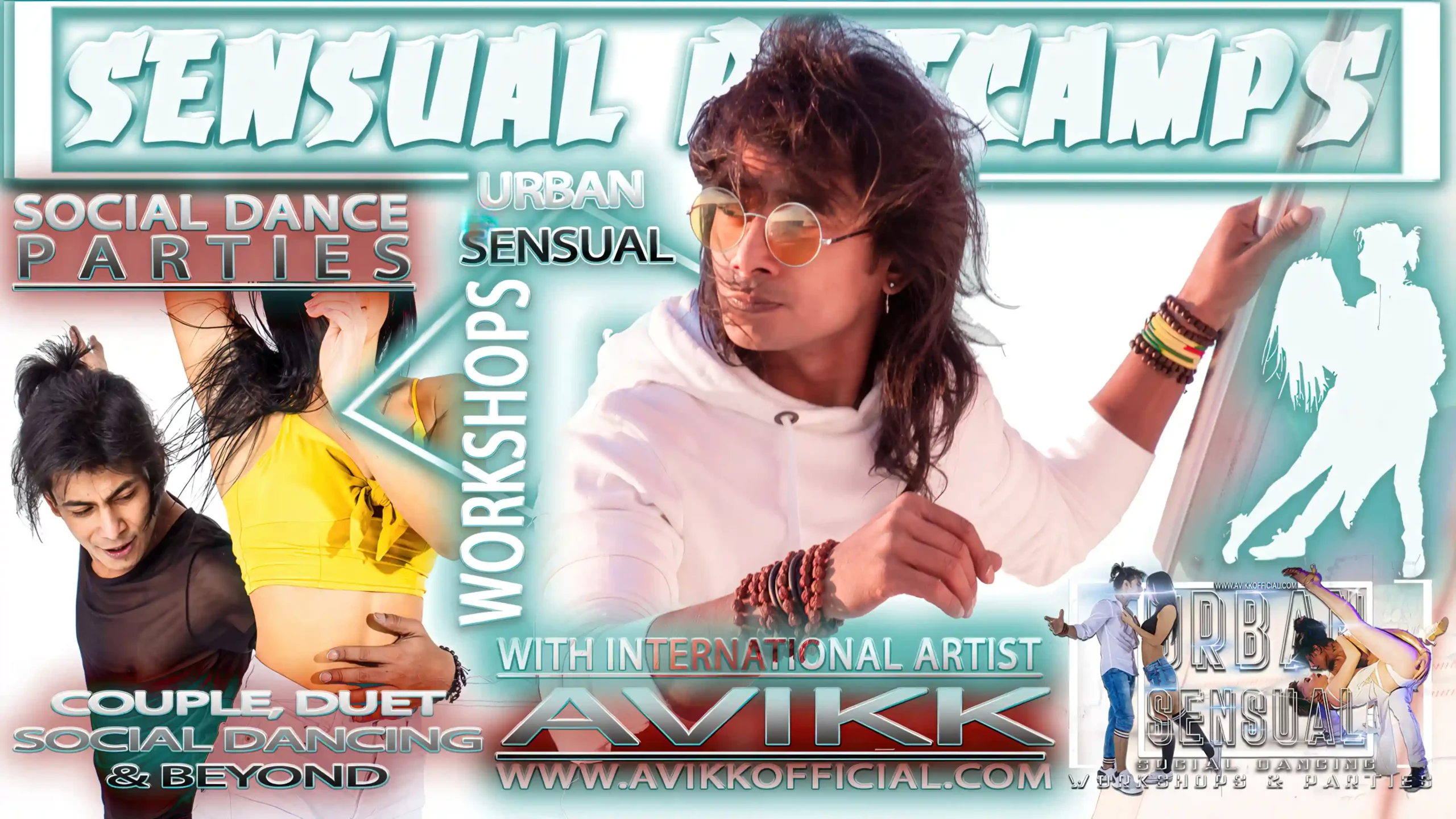

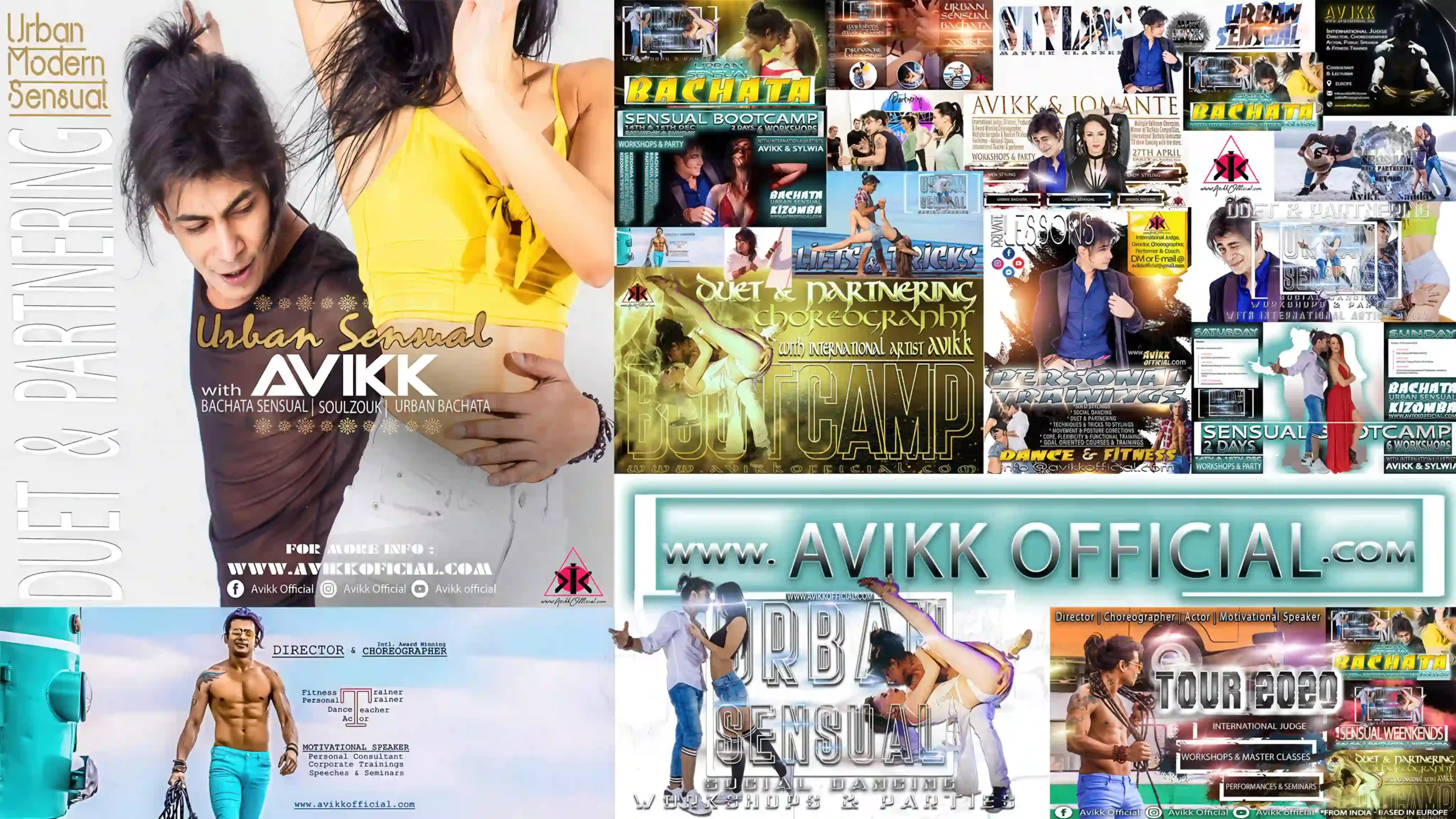


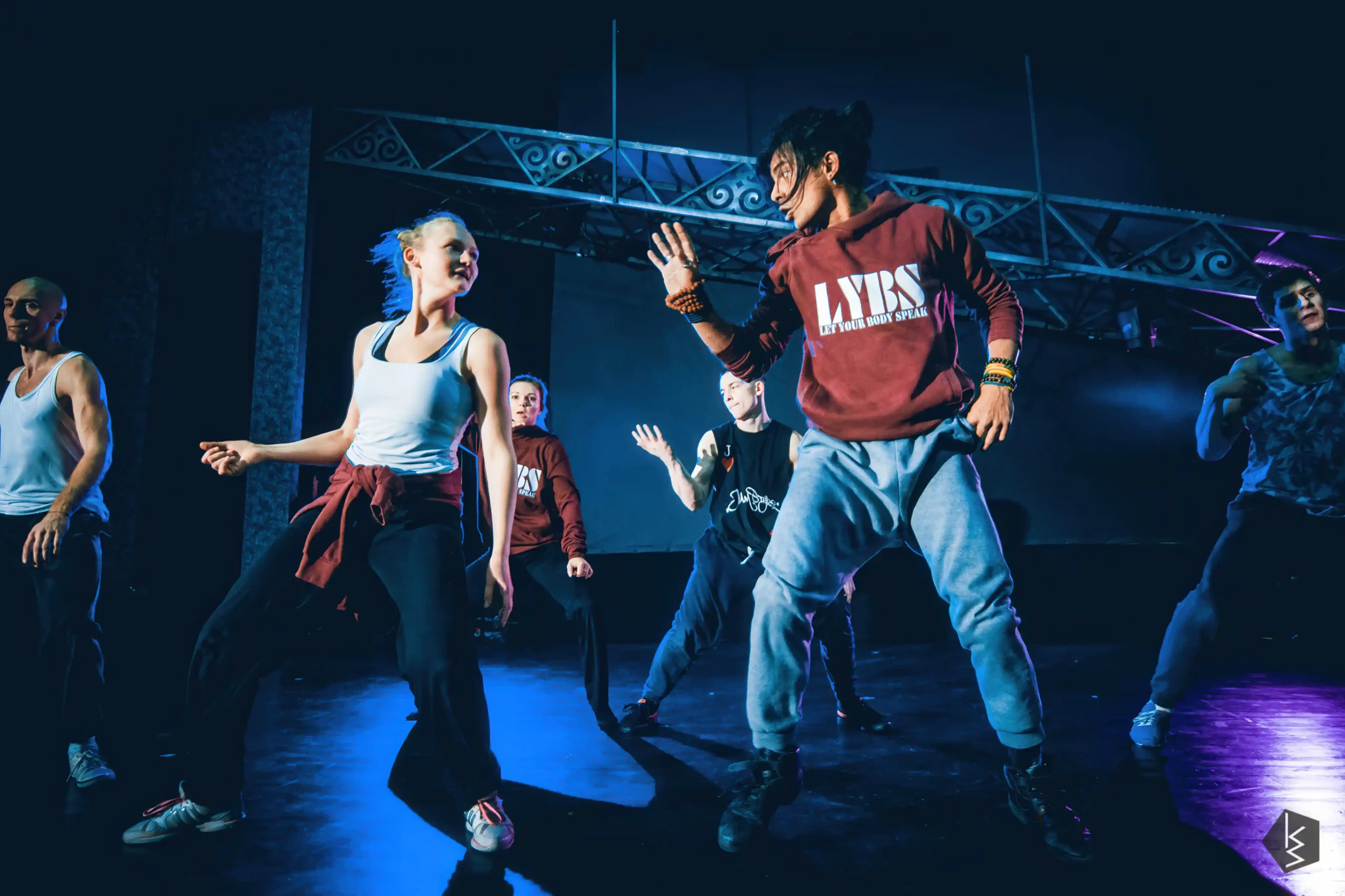

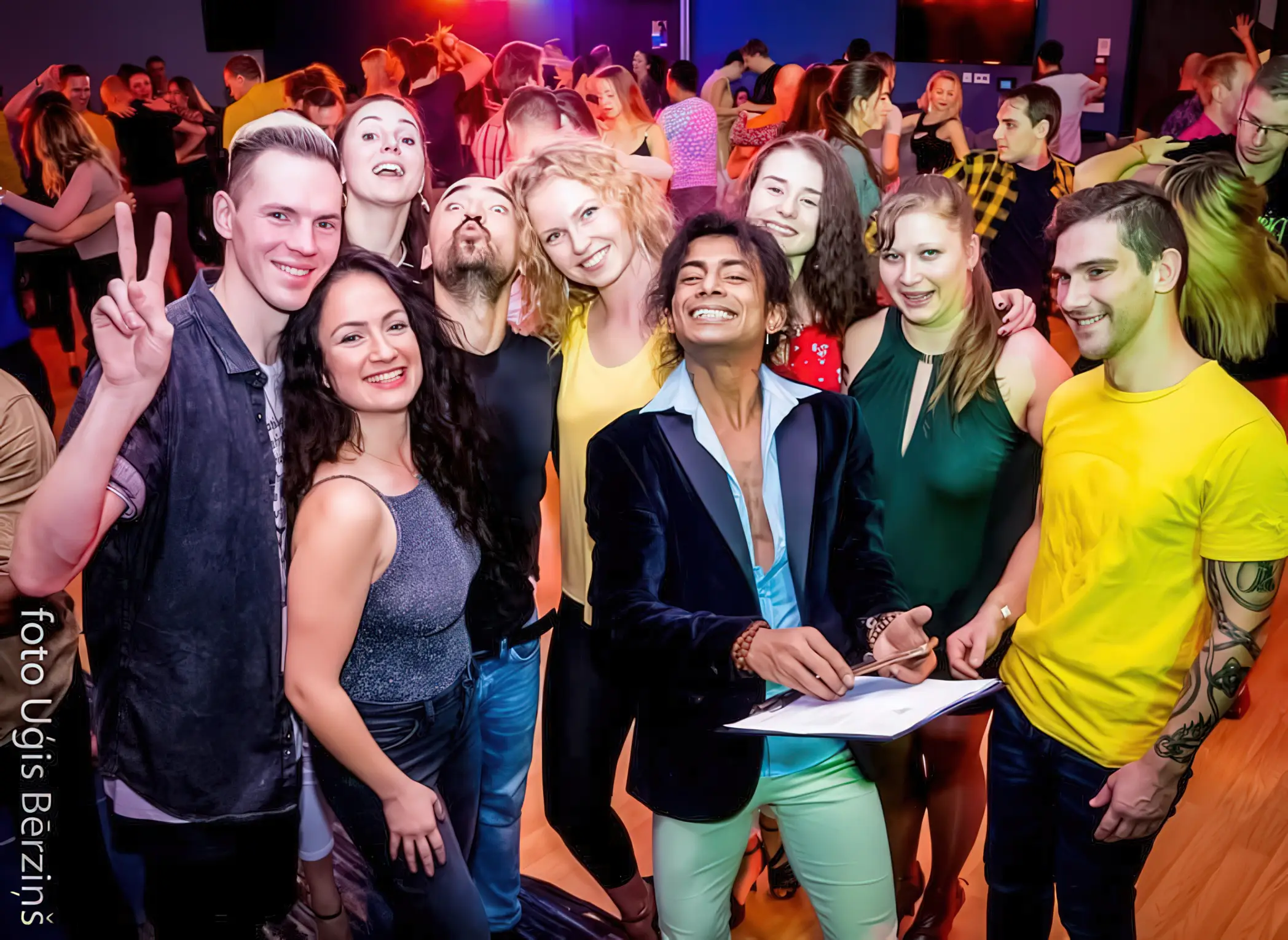
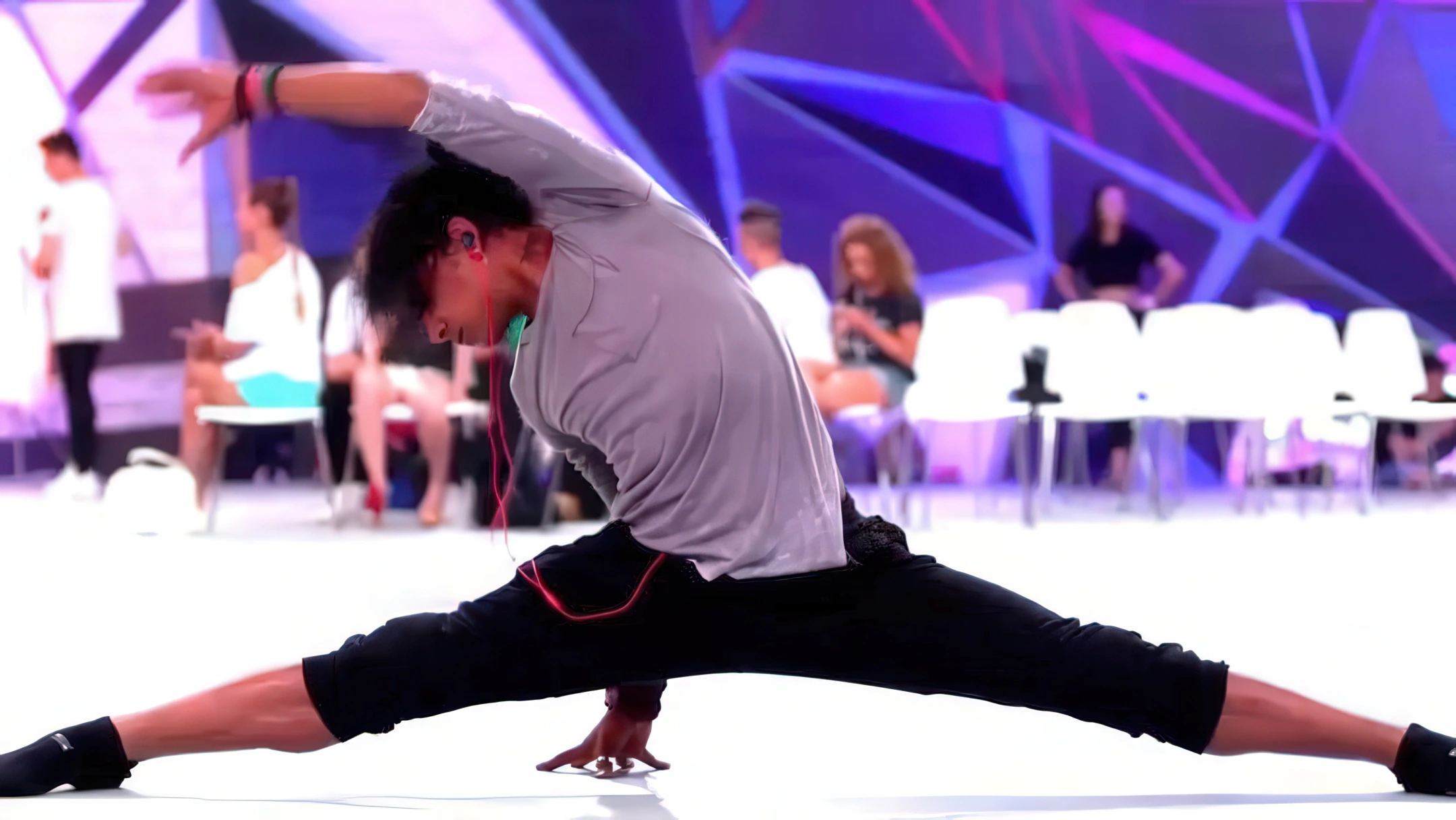
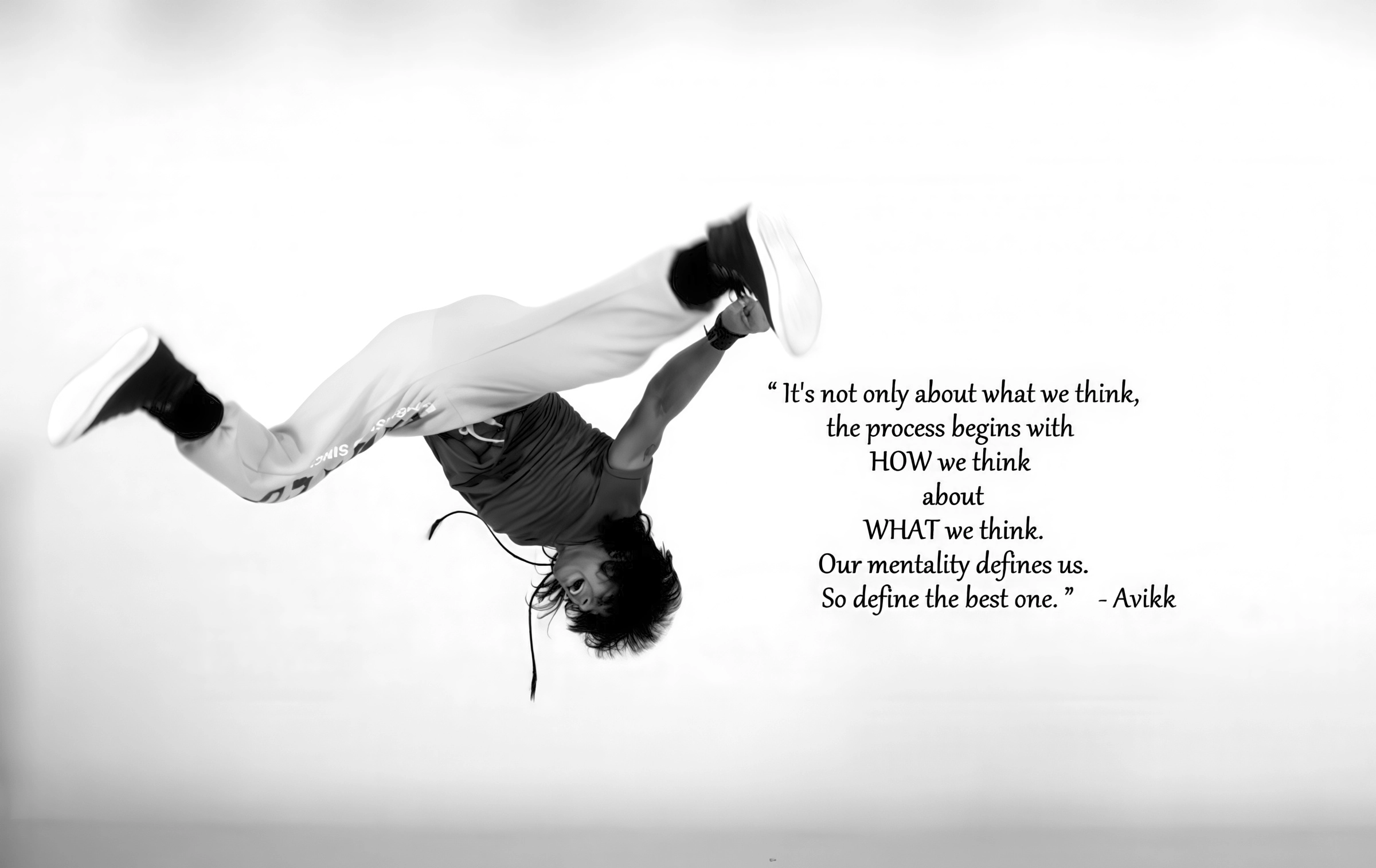
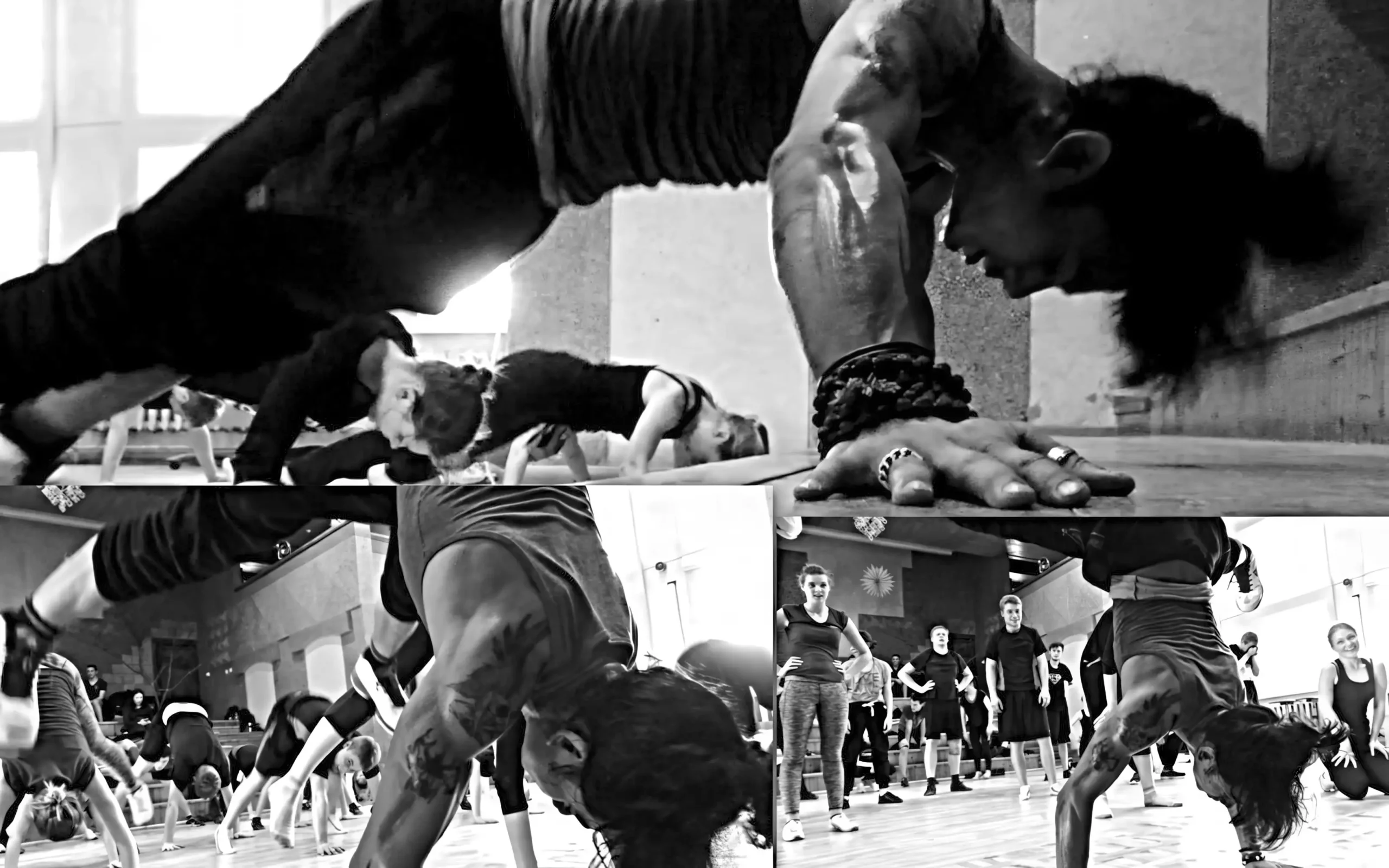





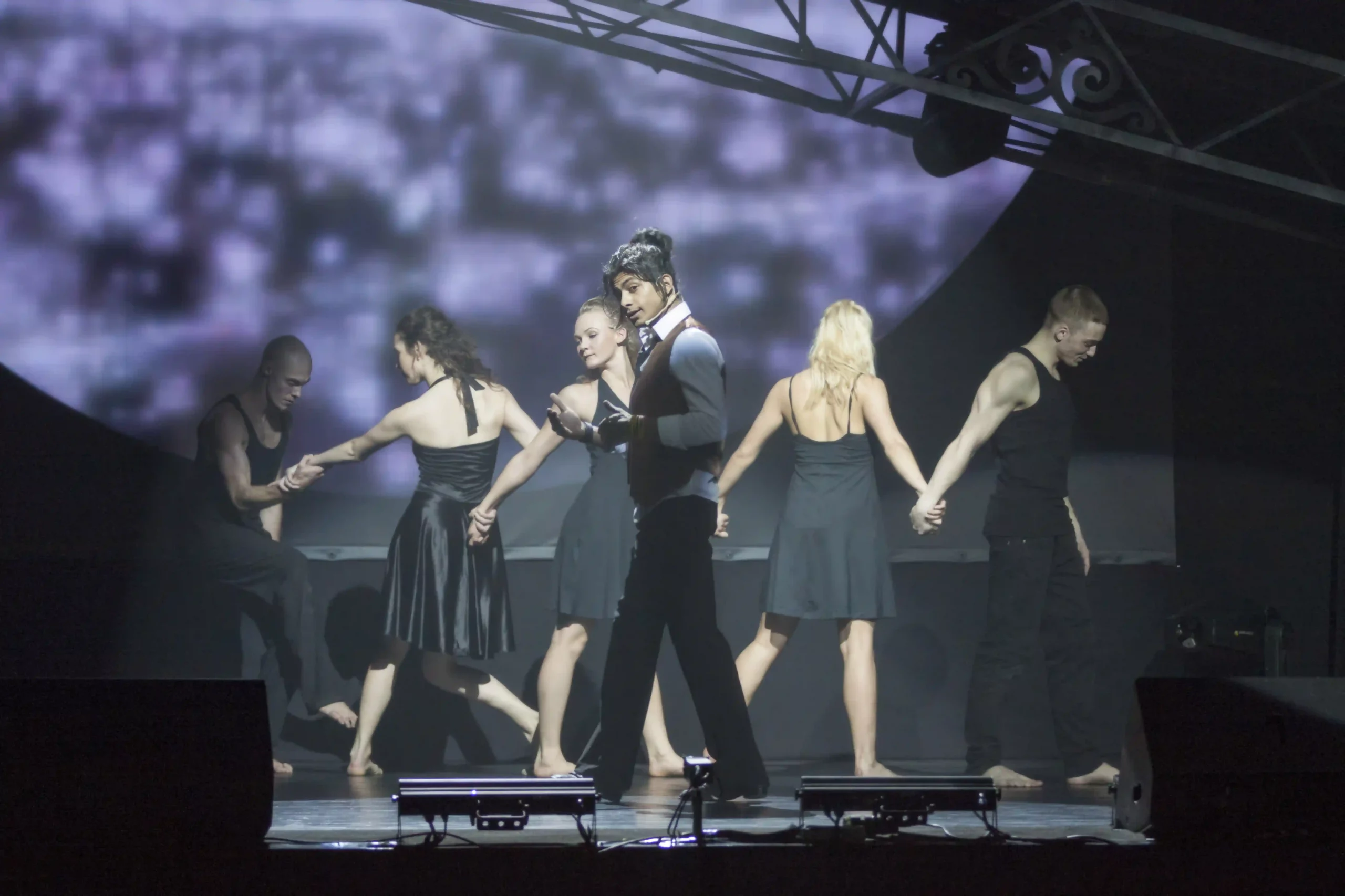
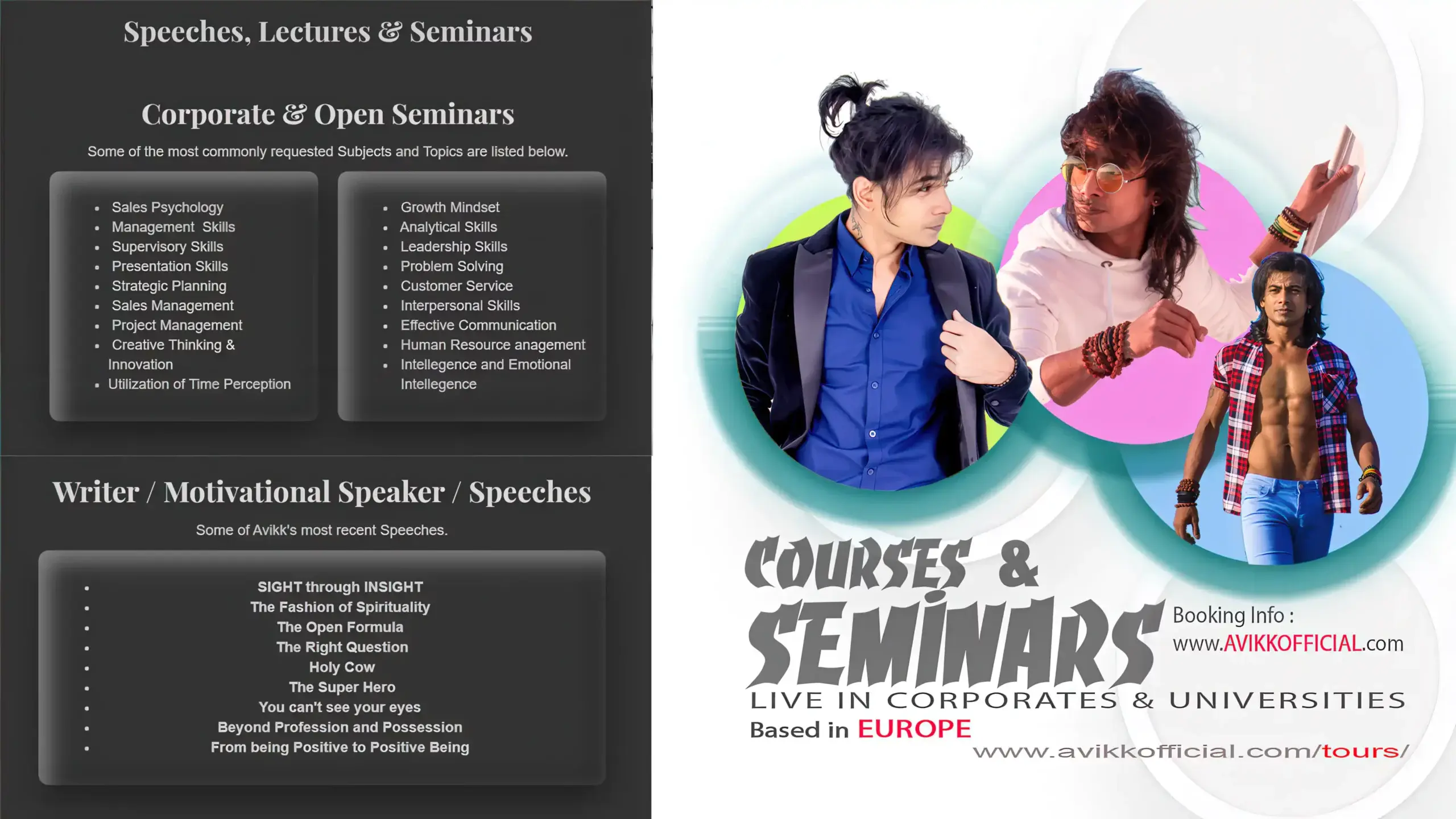
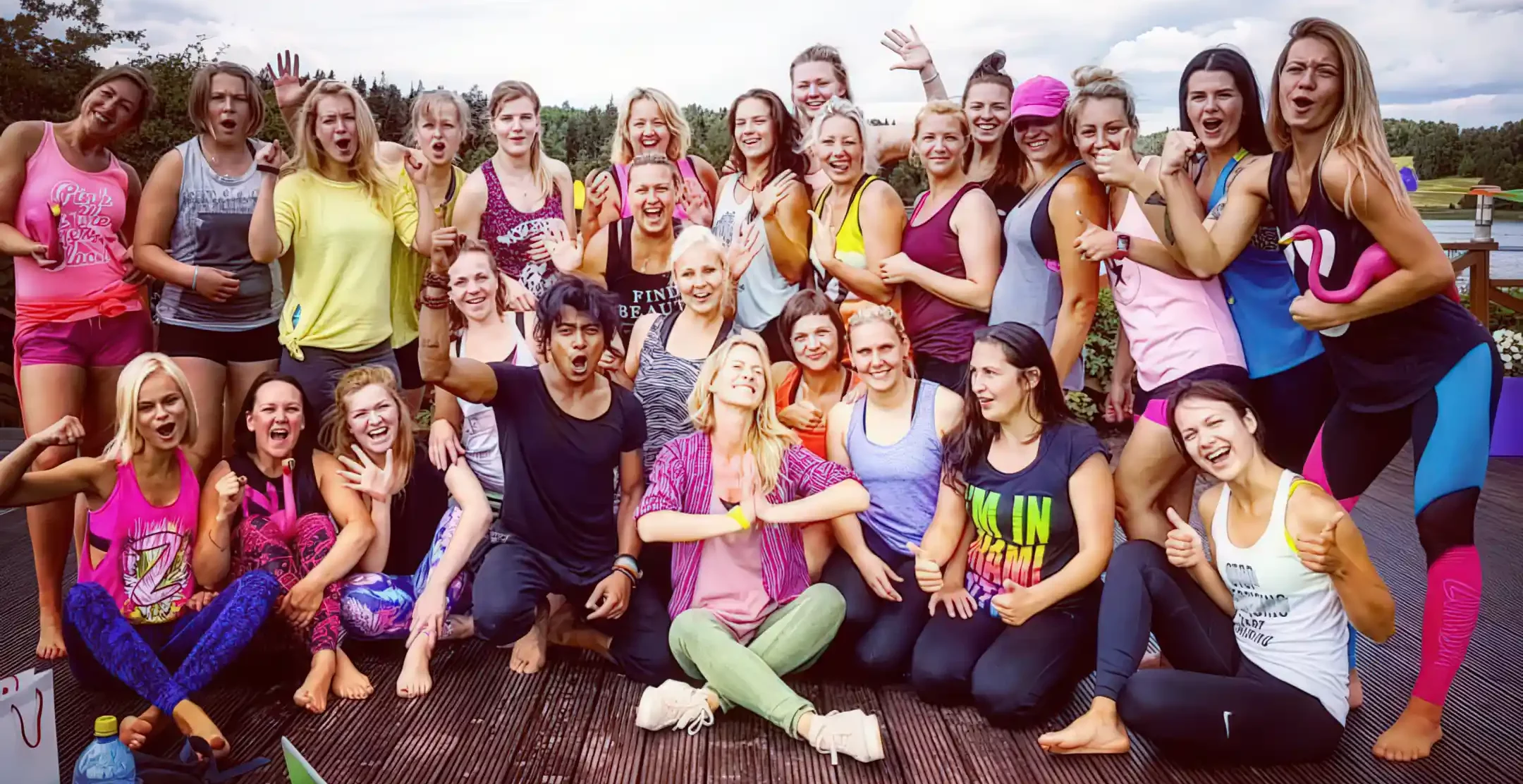

Social dancing, Duet, Partnering & Beyond
Avikk and Xenia’s expertise in social dancing, duet partnering, and improvisational dance positions them as standout instructors in a diverse array of workshops and masterclasses. They offer a comprehensive curriculum that covers social dancing techniques, partner connection, authentic improvisation and performance artistry. Here’s a complete overview of the workshops and masterclasses they provide, expanding on how Avikk and Xenia’s experience creates unmatched value for dancers at every level.
Click to EXPAND on each below:
1. Social Dance Technique and Styling
1.1. Basics of Social Dance
- Foundation steps and techniques for beginners in various social dance styles.
- Introduction to rhythm, timing, and musicality.
- Building confidence and comfort in social dance settings.
1.2. Intermediate Social Dance Patterns and Transitions
- Developing dance vocabulary and learning seamless transitions.
- Understanding lead and follow techniques for enhanced partner connection.
- Exercises to adapt to different social dance environments and partners.
1.3. Advanced Styling and Flourishes
- Techniques for adding personal style to social dancing.
- Advanced footwork, turns, and embellishments for more dynamic movement.
- Building individual expression within the framework of social dance.
2. Partner Connection and Communication
2.1. The Art of Lead and Follow
- Techniques for effective non-verbal communication between partners.
- Understanding partner responsiveness and connection through frame and tension.
- Exercises to develop trust and coordination in leading and following.
2.2. Building Physical and Emotional Connection
- Techniques to enhance emotional connection and storytelling in duets.
- Exercises in presence, eye contact, and breathing synchronization.
- Creating authentic chemistry and flow in partner dancing.
2.3. Non-Verbal Communication and Cueing
- Understanding and practicing subtle cues in partner dancing.
- Techniques for clear and intentional movements that guide the dance.
- Exercises in sensitivity and adaptability to enhance partner responsiveness.
3. Dance Improvisation and Creative Expression
3.1. Authentic Improvisation in Duet Dance
- Techniques for improvising with a partner while maintaining cohesion.
- Exercises to move beyond rehearsed steps and create in-the-moment movement.
- Developing adaptability and flow to interpret music spontaneously.
3.2. Expressive Partnering and Storytelling
- Techniques to communicate emotions and narratives through dance.
- Exploring themes and character dynamics in improvisational dance.
- Building expression and storytelling skills in duet contexts.
3.3. Solo and Partnered Improvisation Techniques
- Exercises to practice both solo and partnered improvisational skills.
- Techniques for creative solo expressions within a duet structure.
4. Performance and Stage Presence
4.1. Stage Presence and Performance Quality
- Techniques to command attention and create a lasting impact on stage.
- Exercises in projecting confidence, energy, and charisma.
- Adapting stage presence for different venues, from small showcases to large events.
4.2. Musical Interpretation and Dynamic Movement
- Techniques to enhance musical interpretation in performance.
- Exercises for varying dynamics, timing, and textures in response to music.
- Building a captivating performance through creative musicality.
4.3. Theatrical and Emotional Elements in Partner Dance
- Incorporating dramatic expressions and character into partner dancing.
- Techniques to amplify emotions and convey complex themes.
- Creating a deeper connection with the audience through theatrical elements.
5. Dance Styles and Fusion Techniques
5.1. Salsa, Bachata, and Latin Dance Foundations
- Foundation techniques, patterns, and footwork for popular Latin dances.
- Exercises to develop Latin styling, hip movements, and rhythmic interpretation.
- Building confidence in social Latin dance styles for social events and performances.
5.2. Contemporary Partner Dance Fusion
- Combining elements of contemporary dance with partner-based movement.
- Techniques for fluid movement, lifts, and transitions unique to contemporary styles.
- Exercises to adapt contemporary forms into duet dance and social dancing.
5.3. Ballroom and Smooth Dance Techniques
- Techniques for ballroom styles like Waltz, Foxtrot, and Tango.
- Exercises in poise, posture, and traditional ballroom partnering.
- Building versatility to dance socially in a ballroom setting.
5.4. Cross-Genre Fusion (Latin, Hip-Hop, and Contemporary)
- Techniques for blending Latin, hip-hop, and contemporary movements.
- Exercises to develop versatile dance styles that mix genres.
- Creating unique dance identities through fusion in duet formats.
6. Partnering Techniques and Lifts
6.1. Fundamentals of Partnering Mechanics
- Techniques for secure, controlled lifts and weight-sharing movements.
- Understanding body alignment, balance, and coordination.
- Exercises to ensure safety and control in partnered lifts.
6.2. Dynamic Partnering and Aerial Work
- Advanced partnering techniques, including dynamic lifts and aerial moves.
- Exercises for building strength, trust, and timing for complex lifts.
- Techniques for graceful transitions and fluid movement in partnered acrobatics.
6.3. Contact Improvisation for Partnering
- Techniques in contact improvisation for deeper partner connection.
- Exploring momentum, weight, and shared energy in movement.
- Exercises to maintain fluid, responsive movement with a partner.
7. Choreography and Movement Composition
7.1. Creating Duet Choreography
- Techniques for designing duet choreography from start to finish.
- Exercises to develop cohesive movements that showcase partner dynamics.
- Building choreography that highlights emotional and rhythmic expression.
7.2. Story-Driven Choreographic Elements
- Developing narratives within choreography to convey meaning.
- Techniques to integrate character and story into movement sequences.
- Creating memorable, story-based performances through choreography.
7.3. Collaborative Composition with a Partner
- Exercises in co-creating choreography with shared input and ideas.
- Techniques for balancing creative voices in duet choreography.
- Building collaborative skills for cohesive duet compositions.
8. Social Dance Etiquette and Culture
8.1. Social Dance Etiquette and Floorcraft
- Understanding and practicing etiquette for social dance events.
- Techniques for navigating dance spaces respectfully and safely.
- Exercises in communication and boundary-setting for social dance.
8.2. Building Confidence in Social Dance Spaces
- Techniques to overcome social anxiety and build dance-floor confidence.
- Exercises in comfort, approachability, and enjoyment in social settings.
- Developing a relaxed, confident presence in social dance environments.
8.3. History and Cultural Appreciation of Social Dance
- Workshops on the history and evolution of social dance styles.
- Understanding the cultural roots and significance of different dance forms.
- Building respect and awareness of dance traditions across genres.
9. Specialized Dance Workshops
9.1. Performance Improvisation for Social Dancers
- Techniques to adapt social dance for performance contexts.
- Exercises for expressing individuality and spontaneity on stage.
- Developing on-the-spot performance skills for social dance styles.
9.2. Group Dynamics and Ensemble Partnering
- Techniques for dancing as part of a larger group or ensemble.
- Understanding spatial awareness, timing, and group coordination.
- Exercises for maintaining connection within ensemble and duet forms.
9.3. Musicality in Partner Dance
- Techniques to refine timing, phrasing, and musicality with a partner.
- Developing an intuitive sense of rhythm and beat with music.
- Exercises to enhance connection to the music as a duo.
10. Masterclasses in Dance Education and Teaching
10.1. Dance Education Techniques for Social Dance Teachers
- Techniques for teaching social dance fundamentals to all levels.
- Exercises for creating an inclusive, supportive class environment.
- Adapting teaching styles to different learners in a social dance context.
10.2. Partner Dance Facilitation and Coaching
- Techniques for facilitating partner dance classes and workshops.
- Building confidence in teaching lead-follow dynamics and connection.
- Exercises for adapting instruction to group and individual needs.
10.3. Teaching Improvisation and Self-Expression
- Techniques for fostering creativity and self-expression in students.
- Exercises to teach authentic improvisation and individual style.
- Encouraging dancers to find and express their unique dance voices.
Avikk and Xenia’s workshops and masterclasses for social dancing and duet partnering stand out in the depth and breadth of their curriculum. Their unique expertise enables them to teach everything from fundamental dance techniques to advanced partnering, improvisation, and performance quality, appealing to dancers of all backgrounds. The versatility and quality of Avikk and Xenia’s instruction make them true versatile & unique Performers offering transformative learning experiences that are valuable across all levels.
Whether dancers are looking to improve their technical skills, enhance their connection with partners or develop their unique dance voice, Avikk and Xenia’s workshops provide the tools and insights to achieve excellence in every aspect of social dance and partnering.
Seminars & Methodologies
Avikk’s extensive expertise across performing arts, communication, and corporate training makes him an influential speaker and seminar leader apart from his vast knowledge & Expertise. He is frequently invited to conduct seminars that integrate both theoretical knowledge and hands-on methodologies, tailored to diverse professional and artistic settings. His seminars are known for their depth, relevance, and practical impact, making him stand out among other speakers and trainers. Here’s a comprehensive overview of the types of seminars Avikk leads, categorized by topics and methodologies that highlight his unique skill set and approach.
Click to EXPAND on each below:
1. Communication and Leadership Seminars
1.1. Advanced Verbal and Non-Verbal Communication
- Focus: Enhancing communication through body language, voice modulation, and facial expressions.
- Methodologies: Live demonstrations, role-plays, video analysis, feedback sessions.
1.2. Leadership Communication and Executive Presence
- Focus: Building confidence, assertiveness, and empathy to cultivate a strong presence.
- Methodologies: Case studies, mock scenarios, self-assessment tools, group discussions.
1.3. Conflict Resolution and Negotiation Skills
- Focus: Handling workplace conflicts and effective negotiation.
- Methodologies: Role-plays, conflict resolution models, real-world scenarios.
1.4. Emotional Intelligence in Communication
- Focus: Enhancing self-awareness, empathy, and interpersonal skills.
- Methodologies: Self-reflection activities, emotion regulation exercises, group discussions.
2. Corporate Performance and Presentation Skills
2.1. Mastering Public Speaking and Presentation Skills
- Focus: Improving speech structuring, storytelling, and audience engagement.
- Methodologies: On-stage practice, speech critiques, storytelling exercises.
2.2. The Art of Persuasive Communication
- Focus: Crafting persuasive messages and influencing decision-making.
- Methodologies: Persuasion exercises, real-life case studies, feedback sessions.
2.3. Enhancing Vocal Presence and Projection
- Focus: Strengthening vocal clarity, pitch control, and tonal emphasis.
- Methodologies: Voice training, breathing techniques, recording playback.
3. Creativity and Innovation Seminars
3.1. Creative Thinking and Problem-Solving Techniques
- Focus: Cultivating innovative thinking and fresh approaches to problem-solving.
- Methodologies: Brainstorming sessions, mind-mapping, team-based problem-solving.
3.2. Storytelling for Branding and Marketing
- Focus: Building narratives that emotionally engage with target audiences.
- Methodologies: Storyboarding, brand personality exercises, collaborative storytelling.
3.3. Design Thinking and Innovation Process
- Focus: Applying design thinking for customer-centric business solutions.
- Methodologies: Prototyping, group brainstorming, case studies.
4. Performing Arts and Personal Expression
4.1. Authenticity in Performance and Self-Expression
- Focus: Encouraging unique personal expression and emotional depth in performance.
- Methodologies: Self-reflective activities, expressive movement exercises, group feedback.
4.2. Understanding Stage Presence and Audience Engagement
- Focus: Using energy and presence to connect with an audience.
- Methodologies: On-stage practice, audience interaction techniques, confidence-building.
4.3. Dance as a Form of Self-Development and Mindfulness
- Focus: Blending dance with mindfulness for stress relief and self-awareness.
- Methodologies: Guided movement, mindfulness practices, breathing techniques.
5. Team Dynamics and Collaboration
5.1. Building Strong Team Communication
- Focus: Fostering trust and open dialogue within teams.
- Methodologies: Team-building activities, trust exercises, role-plays.
5.2. Collaborative Problem-Solving and Decision-Making
- Focus: Strategies for group decision-making and problem-solving.
- Methodologies: Team role-playing, problem-solving challenges, group discussions.
5.3. Embracing Diversity and Cultural Sensitivity in Teams
- Focus: Recognizing biases, fostering inclusivity, cross-cultural communication.
- Methodologies: Cultural sensitivity exercises, case studies, discussion circles.
6. Personal and Professional Development
6.1. Building Confidence and Self-Awareness
- Focus: Developing self-confidence, identifying strengths and values.
- Methodologies: Self-assessment, visualization exercises, group sharing.
6.2. Time Management and Productivity Skills
- Focus: Techniques for task prioritization, goal setting, focus.
- Methodologies: Productivity planning, time-tracking, prioritization activities.
6.3. Overcoming Public Speaking Anxiety
- Focus: Managing public speaking anxiety and building resilience.
- Methodologies: Breathing exercises, visualization, gradual exposure.
7. Health, Wellness, and Stress Management
7.1. Mindfulness and Stress Reduction Techniques
- Focus: Incorporating mindfulness for mental well-being.
- Methodologies: Guided meditation, relaxation exercises, breath control.
7.2. Physical Wellness Through Movement and Dance
- Focus: Using movement as a tool for stress relief and wellness.
- Methodologies: Dance warm-ups, partner exercises, group sharing.
7.3. Work-Life Balance and Self-Care Strategies
- Focus: Prioritizing self-care to prevent burnout.
- Methodologies: Self-care planning, boundary-setting, group discussions.
8. Corporate Social Responsibility and Ethics
8.1. Understanding and Implementing CSR in Organizations
- Focus: Developing sustainable and responsible business practices.
- Methodologies: Case studies, CSR brainstorming, ethical discussion forums.
8.2. Ethical Leadership and Integrity in Business
- Focus: Fostering integrity and ethics in corporate culture.
- Methodologies: Ethical dilemma scenarios, case studies, group discussions.
9. Educational Methodology for Trainers and Educators
9.1. Effective Teaching and Training Techniques
- Focus: Creating engaging and interactive learning experiences.
- Methodologies: Micro-teaching, peer feedback, learning style assessments.
9.2. Communication for Educators: Engaging Students
- Focus: Building clarity, pacing, and engagement in teaching.
- Methodologies: Voice projection exercises, feedback circles.
9.3. Motivating and Inspiring Students
- Focus: Encouraging a positive learning environment and rapport.
- Methodologies: Storytelling, case studies, collaborative planning.
10. Business Strategy and Personal Branding
10.1. Personal Branding for Professionals
- Focus: Creating a strong professional presence.
- Methodologies: Brand statement development, storytelling, feedback sessions.
10.2. Corporate Branding and Reputation Management
- Focus: Building and maintaining corporate brand trust and reputation.
- Methodologies: Branding workshops, brand identity exercises.
10.3. Strategic Thinking and Business Innovation
- Focus: Developing strategic thinking and business growth.
- Methodologies: Strategy games, SWOT analysis, innovation exercises.
11. Spiritual Seminars
11.1. Mindfulness and Meditation for Stress Management
- Focus: Reducing stress through mindfulness and meditation.
- Methodologies: Guided meditation, breath awareness, body scan.
11.2. Discovering Inner Potential and Emotional Intelligence
- Focus: Self-awareness, emotional regulation, empathy.
- Methodologies: Reflection exercises, mindfulness, group activities.
11.3. Chakra Balancing and Energy Healing
- Focus: Harmonizing energies and emotional healing.
- Methodologies: Chakra meditation, visualization, energy exercises.
11.4. Consciousness and Higher Awareness
- Focus: Awakening deeper self-awareness and mindfulness.
- Methodologies: Mindfulness practices, awareness exercises.
11.5. Spiritual Intelligence in Leadership
- Focus: Empathy, purpose, and ethics in leadership.
- Methodologies: Reflective dialogue, case studies, SQ exercises.
Interactive Professional Workshops
On Premise Trainings & Courses
Seminars, Guest Lecturer & Speaker
Avikk’s seminars and lectures transcend traditional learning experiences—they are immersive journeys that blend inspiration, hands-on learning, and practical insights. Unlike typical seminars that focus solely on information delivery, Avikk’s sessions engage participants on a deeper level, drawing from his vast experience in multiple fields, including performing arts, corporate coaching, and international brand consultancy. Each seminar is carefully crafted to resonate with the audience, incorporating storytelling, real-life case studies, and dynamic interactions that make complex topics relatable and impactful.
Defining Practical Spirituality
Practical Spirituality, as defined by Avikk, is an approach that respects and honors the wisdom of traditional spiritual practices while distilling what is genuinely useful and applicable to modern life. It is not about abandoning tradition; rather, it’s about enhancing it with methods that directly address the challenges of our current, fast-paced world. Avikk’s approach centers on making spirituality a grounded, productive force that can be integrated into every aspect of daily life.
This approach dismisses practices that may feel overly esoteric or disconnected from real life while reinforcing the core of spirituality: inner peace, compassion, purpose, and self-awareness. Practical Spirituality is about cutting through dilutions and misconceptions, making spiritual growth accessible and empowering for people at any stage of their journey.
Click to EXPAND on each below:
1. Defining Practical Spirituality
1.1 Accessible and Grounded
- Focus: Simplifying spiritual concepts to make them applicable to daily life.
- Methodologies: Interactive sessions, relatable examples, practical exercises.
1.2. Real-Life Application Focus
- Focus: Using spirituality to enhance relationships, well-being, and everyday experiences.
- Methodologies: Scenario-based learning, group discussions, and real-life application techniques.
2. Scientific and Result-Oriented Approach
2.1. Evidence-Based Teachings
- Focus: Drawing from psychology, neuroscience, and wellness science to support practices.
- Methodologies: Research insights, science-backed exercises, measurable progress tracking.
2.2. Measurable Benefits
- Focus: Achieving tangible improvements such as stress reduction and emotional resilience.
- Methodologies: Feedback sessions, tracking emotional resilience, stress reduction exercises.
3. Mindfulness and Present Moment Awareness
3.1. Addressing Distraction and Anxiety
- Focus: Teaching mindfulness to reduce anxiety and increase present-moment awareness.
- Methodologies: Guided mindfulness, distraction-management techniques, live practice.
3.2. Benefits of Being Present
- Focus: Improving focus and emotional engagement by staying in the moment.
- Methodologies: Focused breathing, grounding exercises, present-moment awareness training.
4. Emotion Channeling
4.1. Recognizing Emotions as Energy
- Focus: Viewing emotions as energy to be constructively channeled.
- Methodologies: Emotion analysis exercises, energy redirection techniques, journaling.
4.2. Techniques for Constructive Channeling
- Focus: Transforming emotions like anger or sadness into productive outlets.
- Methodologies: Creative activities, problem-solving techniques, emotional redirection practices.
5. Breaking Free from Limiting Beliefs
5.1. Identifying Mental Blocks
- Focus: Uncovering and addressing beliefs that restrict personal growth.
- Methodologies: Self-reflective exercises, limiting belief analysis, group feedback.
5.2. Releasing Personal Potential
- Focus: Removing self-imposed limitations to unlock new possibilities.
- Methodologies: Guided visualization, self-empowerment activities, confidence-building sessions.
6. Discovering Authentic Purpose and Passion
6.1. Connecting with Core Values
- Focus: Helping individuals align with their deepest values and passions.
- Methodologies: Value clarification exercises, purpose-finding techniques, vision mapping.
6.2. Experiencing Fulfillment and Satisfaction
- Focus: Finding a true sense of purpose for motivation and life satisfaction.
- Methodologies: Purpose-driven goal setting, self-reflection, purpose alignment activities.
7. Avikk’s Personal Learnings through it
7.1. Real-Life Example of Transformation
- Focus: Sharing Avikk’s own breakthroughs to illustrate the impact of these methods.
- Methodologies: Personal anecdotes, case studies, before-and-after insights.
7.2. Self-Discovery through Intuition
- Focus: Using personal experiences to highlight the power of honesty and introspection.
- Methodologies: Introspection exercises, intuition-building techniques, self-realization practices.
8. Transforming Anxiety and Fear
8.1. Growth through Breathwork and Mindfulness
- Focus: Teaching practical tools for managing anxiety and fear.
- Methodologies: Breathwork exercises, guided mindfulness, gradual exposure practices.
8.2. Practical Solutions for Common Issues
- Focus: Equipping participants with tools to face fears and foster personal growth.
- Methodologies: Real-life scenarios, resilience training, group discussions.
9. Creating Sustainable Change in All Areas of Life
9.1. Building Resilience and Inner Stability
- Focus: Encouraging techniques for long-lasting resilience and inner strength.
- Methodologies: Resilience exercises, consistency-building practices, stress management tools.
9.2. Consistency and Balance Across Life Areas
- Focus: Promoting a balanced approach to relationships, work, and self-development.
- Methodologies: Time management techniques, self-assessment, balance mapping.
10. Emphasizing Honest, Impartial Self-Reflection
10.1. Clarity through Honest Self-Reflection
- Focus: Encouraging honesty in self-reflection to gain deeper personal insights.
- Methodologies: Reflective journaling, non-judgmental feedback, strengths assessment.
10.2. Self-Awareness as a Foundation for Growth
- Focus: Fostering growth through a clear and honest view of strengths and weaknesses.
- Methodologies: Self-assessment tools, strength-weakness analysis, growth planning.
The Power MULTI-Professional Expertise
In today’s fast-paced, interconnected world, Multi-professional expertise is not just a career advantage; it’s a transformative skill that fosters faster learning, adaptability, and an innovative approach to new challenges. Here’s how a multi-professional background equips us to learn faster, adapt more readily, and thrive in areas we’ve never explored.
Clarity and Self-Awareness
Practical Spirituality prioritizes cultivating self-awareness and mental clarity. Avikk’s methods help individuals understand their thoughts and motivations, leading to better self-regulation and decision-making. This clarity allows people to navigate challenges with a calm and steady mind.
Emotion Channeling
Rather than merely managing or suppressing emotions, Avikk’s Practical Spirituality focuses on channeling emotions into constructive actions. This approach encourages individuals to recognize emotions as a powerful source of energy that, when directed positively, can fuel creativity, strengthen resolve, and deepen personal connections. Avikk helps individuals transform their emotional experiences into purposeful contributions in their personal and professional lives.
Purpose and Intentional Living
Avikk’s approach guides people to identify their authentic purpose and values, integrating them into everyday actions. This alignment fosters a sense of fulfillment and direction, helping individuals lead lives that feel both productive and meaningful.
Inner Stability and Self-Reliance
Practical Spirituality encourages individuals to find stability within themselves rather than seeking validation or happiness from external sources. Avikk’s methods strengthen inner resilience, promoting self-confidence and an independent sense of well-being that withstands life’s ups and downs.
Integration of Science with Tradition
Avikk respects traditional spirituality but refines it with insights from psychology and neuroscience. By connecting these ancient practices with modern science, he creates an approach that feels both spiritually fulfilling and intellectually grounded, making it relatable and practical for modern life.
Accessibility & Applicability for Daily Life
Above all, Practical Spirituality is about distilling wisdom into actionable steps that improve daily life. Avikk’s approach discards overly abstract or impractical concepts, focusing instead on methods like mindfulness, reflection, and purposeful action that bring real results in work, relationships, and personal growth.
Multi-Professional Workshops & Master Classes
Based on Avikk’s extensive expertise & achievements across various fields, here is a categorized list of a few common workshops and masterclasses he gets invited for. These categories include skills from his performance, production, communication, choreography, and creative backgrounds, making for an unmatched, highly versatile professional portfolio.
Click to EXPAND on each below:
1. Performance and Stage Skills
1.1. Public Speaking and Stage Presence
- Building Confidence on Stage
- Engaging Large Audiences
- Storytelling and Narrative Building
- Voice Modulation and Projection
- Managing Stage Fright
1.2. Performance Improvisation
- Techniques for Solo Improvisation
- Duet Improvisation in Partnered Dance
- Creative Expression through Movement
- Developing Spontaneity in Performances
1.3. Showmanship and Charisma
- Enhancing Stage Charisma and Confidence
- Understanding Audience Dynamics
- Elevating Showmanship in Professional Settings
1.4. Musicality and Rhythm in Dance
- Basics of Rhythm Awareness
- Expressing Musicality in Movement
- Advanced Rhythm Interpretation Techniques
2. Dance Techniques and Styles
2.1. Social Dance Styles
- Salsa Techniques (Partnering, Footwork, Styling)
- Bachata Essentials (Connection, Leading & Following)
- Kizomba Mastery (Flow, Body Movement, Connection)
2.2. Contemporary Dance and Urban Styles
- Contemporary Dance Foundations
- Urban Dance Techniques
- Fusion of Urban and Contemporary Dance
- Movement Quality: Fluidity vs. Sharpness
2.3. Bollywood and Fusion Dance
- Authentic Bollywood Choreography
- Blending Bollywood with Western Styles
- Creative Fusion Dance for Performances
2.4. Advanced Dance Techniques
- Isolations and Body Control
- Flow and Fluidity in Dance
- Advanced Partnering Techniques (Dips, Lifts, Tricks)
2.5. Improvisation Techniques for Dancers
- Authentic Improvisation: Moving Beyond Set Patterns
- Developing Spontaneity in Dance Movements
- Techniques for Improvisation in Partner Work
3. Communication and Leadership Skills
3.1. Verbal and Non-Verbal Communication
- Mastering Body Language for Impact
- Building Confidence in Verbal Communication
- Understanding and Using Non-Verbal Cues
3.2. Cross-Cultural Communication
- Cultural Sensitivity in Communication
- Global Etiquette and Diplomacy
- Adapting Communication for International Audiences
3.3. Corporate Communication Skills
- Effective Business Communication
- Communicating with Executive Presence
- Conflict Resolution and Negotiation Skills
3.4. Leadership Communication
- Charismatic and Persuasive Leadership
- Storytelling for Leaders
- Emotional Intelligence in Leadership
4. Artistic and Creative Workshops
4.1. Choreography and Creative Direction
- Basics of Choreography Creation
- Developing Creative Concepts for Dance
- Directing and Staging Performances
4.2. Show Production and Event Planning
- Event Production from Concept to Execution
- Scriptwriting and Storyboarding for Shows
- Building and Managing a Production Team
4.3. Creative Movement Exploration
- Exploring Emotional Movement
- Dance as a Medium for Storytelling
- Techniques for Expressive Movement in Art
4.4. Introduction to Contact Improvisation
- Understanding Physical Communication in Duet
- Developing Trust in Partnered Improvisation
- Lead-Follow Dynamics in Contact Improvisation
5. Hosting, MC, and Event Management
5.1. Professional Hosting and Emceeing
- Engaging and Retaining Audience Attention
- Crafting Engaging Event Scripts
- Handling Live Audiences and Spontaneous Situations
5.2. Building Charisma and Presence as an MC
- Techniques for Captivating Audiences
- Understanding Crowd Dynamics
- Managing Energy and Flow in Events
5.3. Event Planning and Execution
- Essentials of Event Coordination
- Managing Stage Design and Lighting
- Planning and Executing Multi-Genre Performances
6. Corporate and Team Building Workshops
6.1. Team Communication and Collaboration
- Building Trust within Teams
- Enhancing Interpersonal Communication
- Conflict Resolution within Teams
6.2. Creativity and Innovation for Teams
- Creative Problem-Solving Exercises
- Encouraging Innovation through Collaboration
- Improv Techniques to Build Team Cohesion
6.3. Leadership Skills and Development
- Developing Decision-Making Skills
- Leadership through Effective Communication
- Building an Inclusive Team Culture
7. Film, Media, and Production Skills
7.1. On-Camera Presence and Media Training
- Techniques for Appearing Natural on Camera
- Managing Stage Fright for Filmed Performances
- Using Non-Verbal Cues Effectively on Camera
7.2. Scriptwriting and Screenplay Development
- Writing for Storytelling in Film
- Developing a Screenplay from Concept to Completion
- Writing Engaging Dialogue and Character Arcs
7.3. Video Production and Editing Basics
- Essentials of Directing for Film
- Editing Techniques to Enhance Storytelling
- Basics of Camera Angles and Shots
7. Film, Media, and Production Skills
7.1. On-Camera Presence and Media Training
- Techniques for Appearing Natural on Camera
- Managing Stage Fright for Filmed Performances
- Using Non-Verbal Cues Effectively on Camera
7.2. Scriptwriting and Screenplay Development
- Writing for Storytelling in Film
- Developing a Screenplay from Concept to Completion
- Writing Engaging Dialogue and Character Arcs
7.3. Video Production and Editing Basics
- Essentials of Directing for Film
- Editing Techniques to Enhance Storytelling
- Basics of Camera Angles and Shots
8. Brand and Marketing Workshops
8.1. Personal Branding for Creatives
- Building a Unique Artistic Brand
- Effective Marketing Strategies for Artists
- Social Media Techniques for Visibility
8.2. Corporate Branding and Visual Identity
- Understanding Brand Communication
- Crafting Brand Narratives
- Building Brand Identity through Visuals
8.3. Photography and Videography Basics
- Essentials of Composition and Lighting
- Capturing Emotion through Photography
- Videography Techniques for Brand Storytelling
9. Fitness, Wellness, and Dance Conditioning
9.1. Dance Fitness and Body Conditioning
- Dance Workouts for Flexibility and Strength
- Fitness Routines for Endurance
- Stretching Techniques for Dancers
9.2. Mental and Emotional Wellness in Dance
- Managing Stress through Dance and Movement
- Building Emotional Resilience
- Mindfulness Techniques for Performers
9.3. Physical Fitness for Performers
- Fitness Routines for Stage Endurance
- Core Strengthening for Performance
- Injury Prevention Techniques
10. Educational and Academic Workshops
10.1. Educational Workshops for Schools and Institutions
- Introduction to Performing Arts
- Creative Expression for Students
- Basic Choreography for Students
10.2. Workshops for Teachers and Educators
- Techniques for Engaging Classrooms
- Building Effective Teaching Methods
- Storytelling for Educators
10.3. Communication Skills for Academics
- Public Speaking for Educators
- Developing Engaging Presentations
- Conflict Resolution in Classroom Settings
11. Social Media and Digital Communication
11.1. Social Media Strategy for Performers
- Growing a Following on Social Media
- Building Engagement with Content
- Utilizing Visuals to Enhance Online Presence
11.2. Effective Digital Communication
- Writing Compelling Copy for Social Media
- Managing Public Image Online
- Engaging with Followers and Fans
Through his vast and versatile experience, Avikk provides an unmatched range of workshops and masterclasses tailored to both creative and corporate fields, social dance, fitness, branding, production, and beyond. With these offerings, he can deliver both depth and breadth, enabling attendees to gain specialized skills and holistic growth in their chosen areas. Each category allows organizations, artists, students, and professionals to access high-level tools & techniques that blends theory with practical insights, crafted through years of real-world success across multiple industries.
The Power MULTI-Professional Expertise
In today’s fast-paced, interconnected world, Multi-professional expertise is not just a career advantage; it’s a transformative skill that fosters faster learning, adaptability, and an innovative approach to new challenges. Here’s how a multi-professional background equips us to learn faster, adapt more readily, and thrive in areas we’ve never explored.
A Wealth of Knowledge Across Diverse Sectors:
With an impressive resume that spans military training, business development, performing arts, and international brand advisory, Avikk brings a wealth of knowledge that enriches each training session. He isn’t just teaching theory; he brings real-world solutions that are adaptable across industries, making him the go-to trainer for innovation and adaptability in today’s competitive landscape.
Insights from a Proven Corporate Leader:
Avikk’s journey through the corporate ranks, from Sales Leader to Business Development Manager and Brand Advisor, gives him an acute understanding of corporate operations and the strategies that drive success. His hands-on experience with global clients provides insights that teams can directly apply to improve performance, customer relations, and internal communication.
Discipline, Leadership & Precission from Military:
As an ex-Air Force Trainer, Avikk learned the importance of discipline, focus, and team alignment under high-stakes situations. This experience translates seamlessly into corporate training, where he teaches teams how to tackle challenges with resilience, clarity, and strong leadership—qualities that stem directly from his military background.
Creative Visions from Intl.Directions & Productions:
Avikk’s directorial and production expertise enhances his training sessions with a creative approach. Known for his work in opera, TV shows, and large-scale productions, Avikk has mastered the art of engagement. His sessions are more than training—they’re immersive experiences that captivate, inspire, and motivate, ensuring lessons that stick.
Communication Mastery as a Public Speaker and Teacher:
An accomplished public speaker and communication coach, Avikk has trained global audiences to speak with clarity, confidence, and authenticity. His communication coaching is designed to elevate corporate leaders and teams, teaching them not only how to convey messages but also how to inspire, connect, and lead.
Fueling Innovation in Emerging Fields:
Emerging fields—such as AI, renewable energy, and digital health—require individuals who can think beyond traditional boundaries. Multi-professional expertise helps bridge gaps between disciplines, providing innovative solutions that purely specialized minds may overlook. This cross-pollination of ideas is critical in areas where industries intersect, such as tech-art collaborations, bioinformatics, and corporate social responsibility.

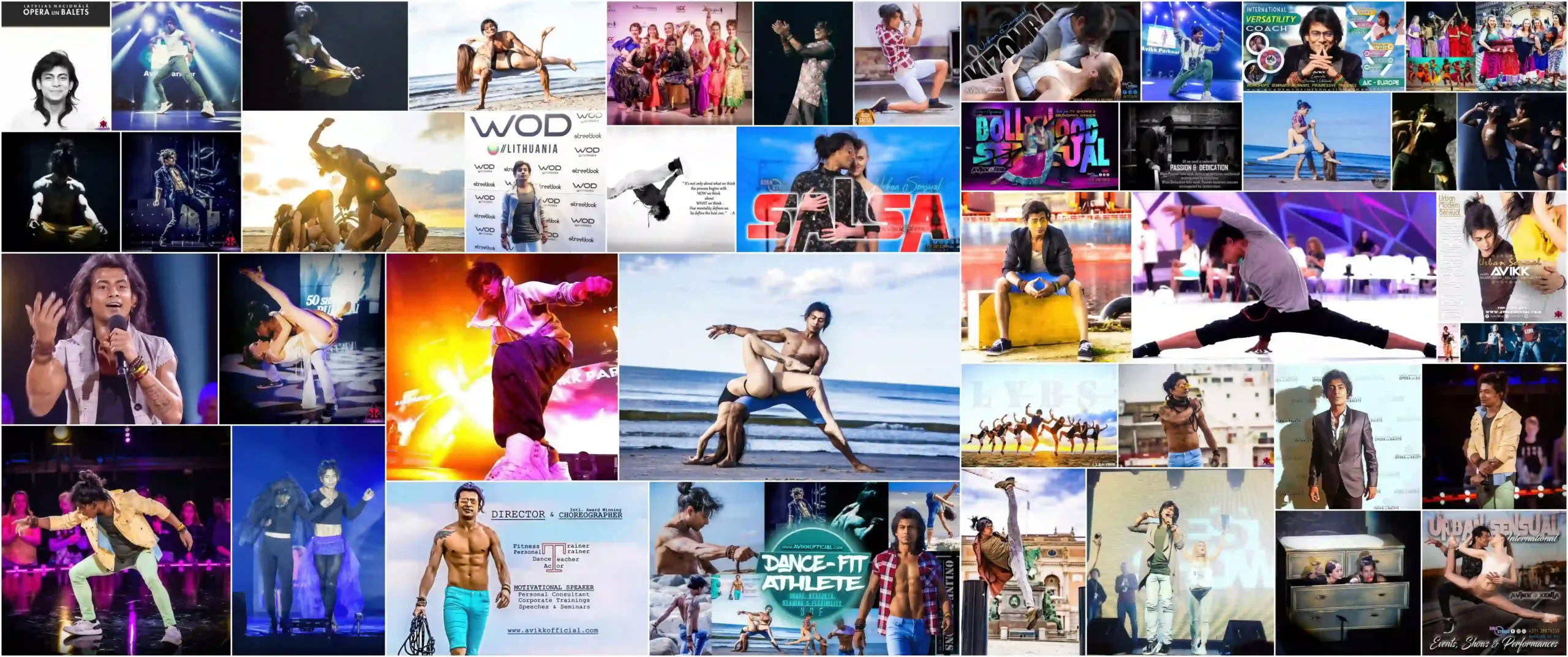
Explore Avikk's all other Expertise on other pages.
Explore Avikk’s Multifaceted Mastery: Unmatched Achievements Across Arts, Leadership, and Innovation
Discover how Avikk’s unique blend of passion, intellect, and spirituality can transform our professional & even personal journey.

